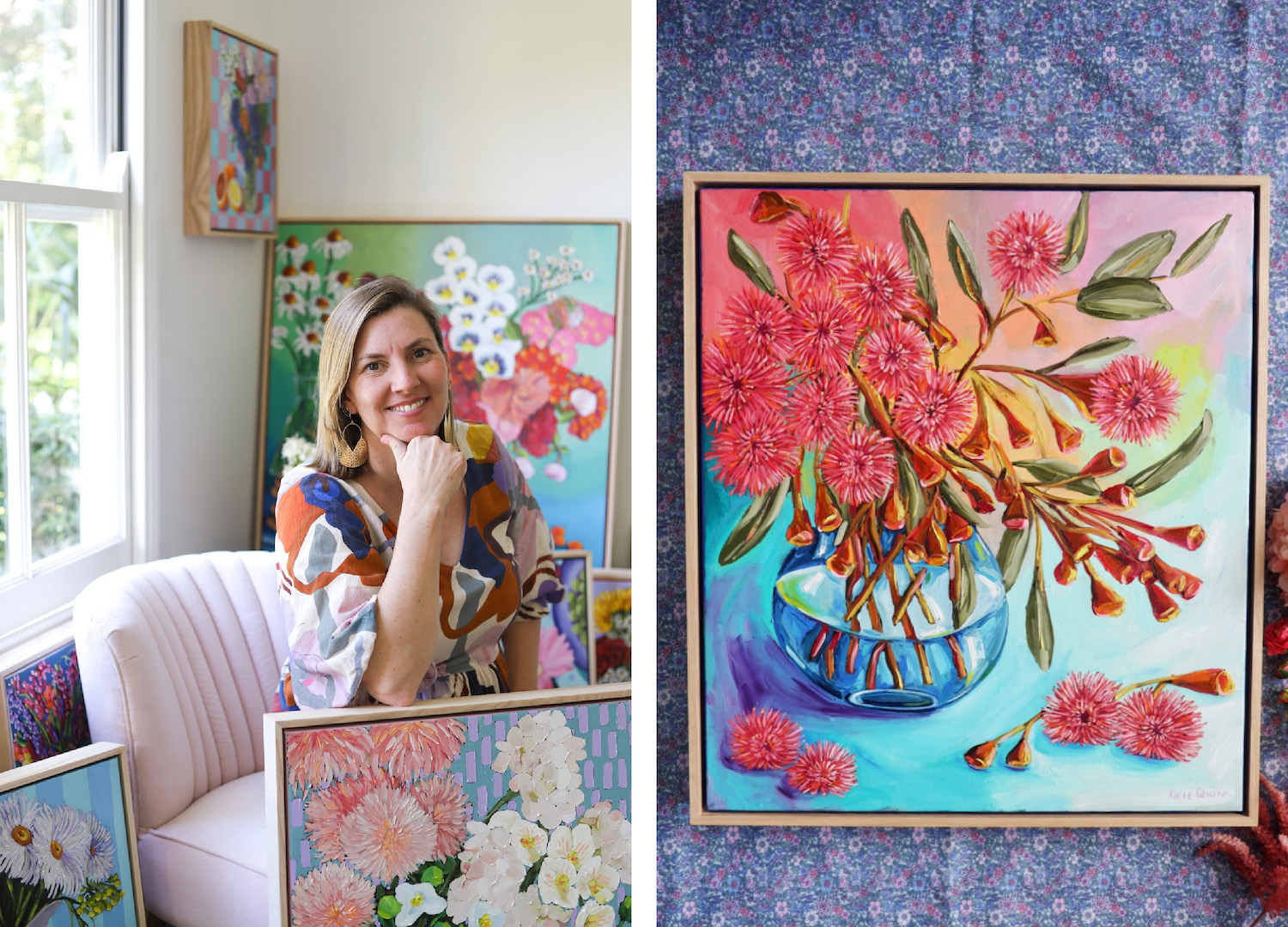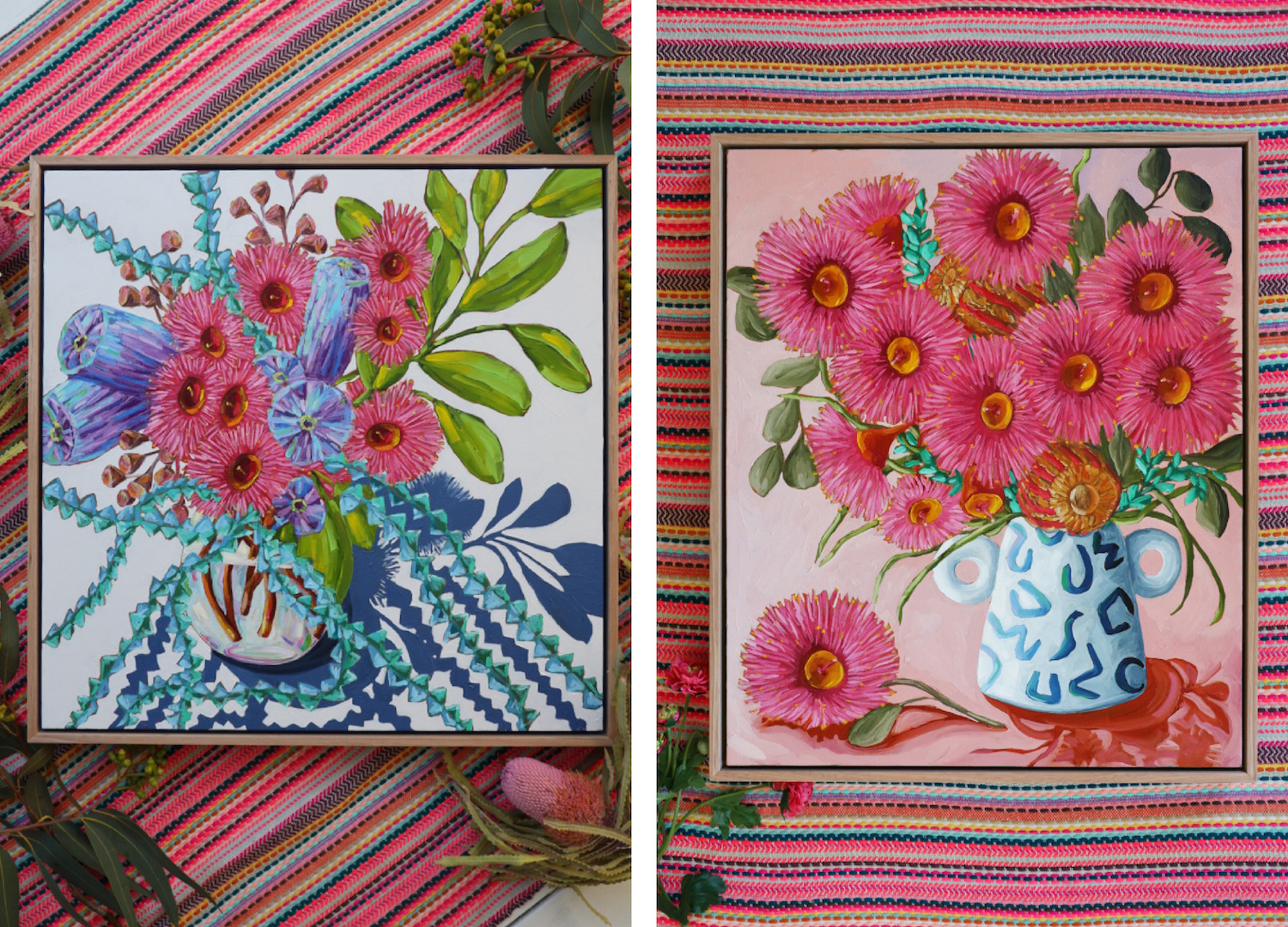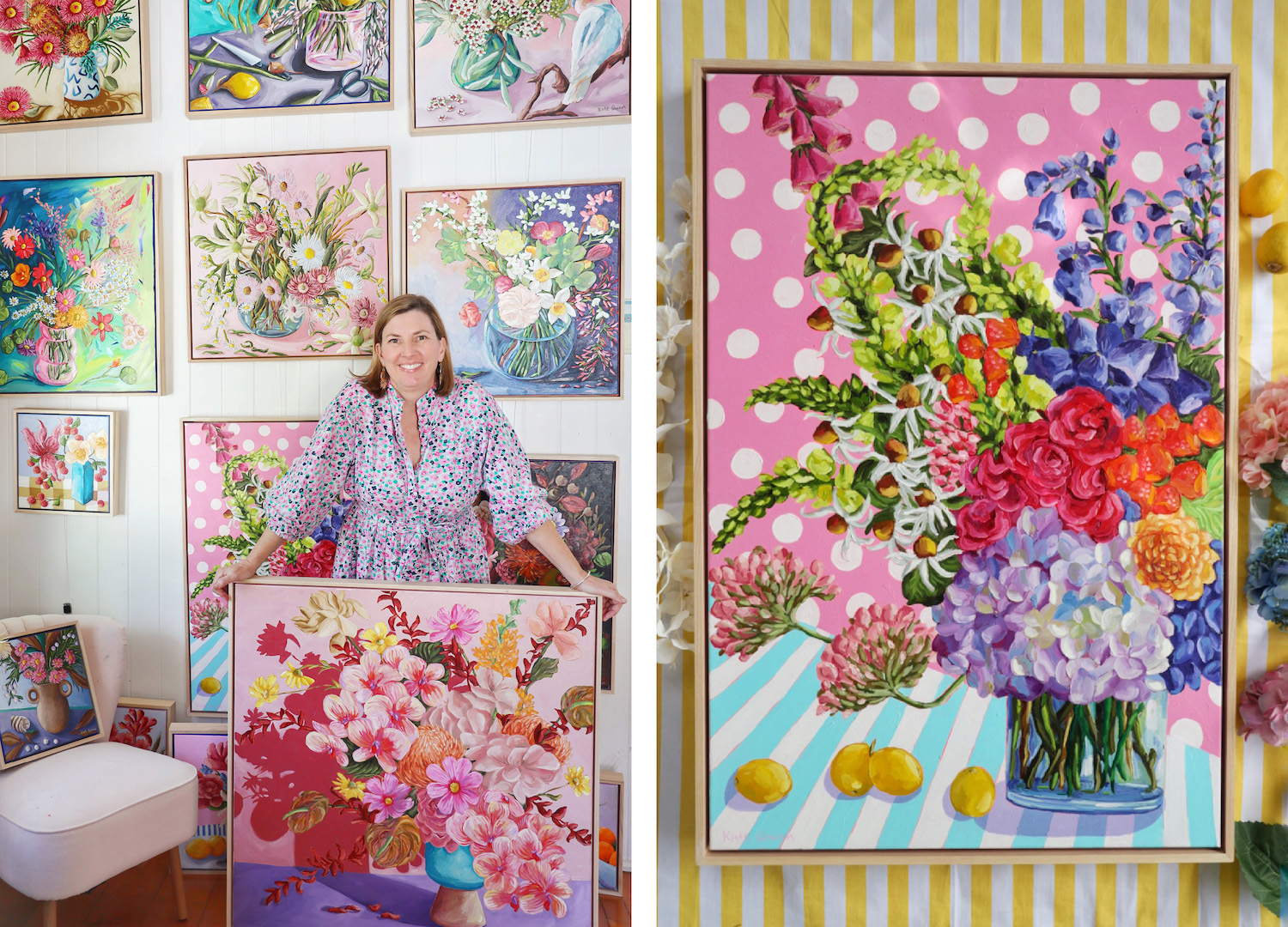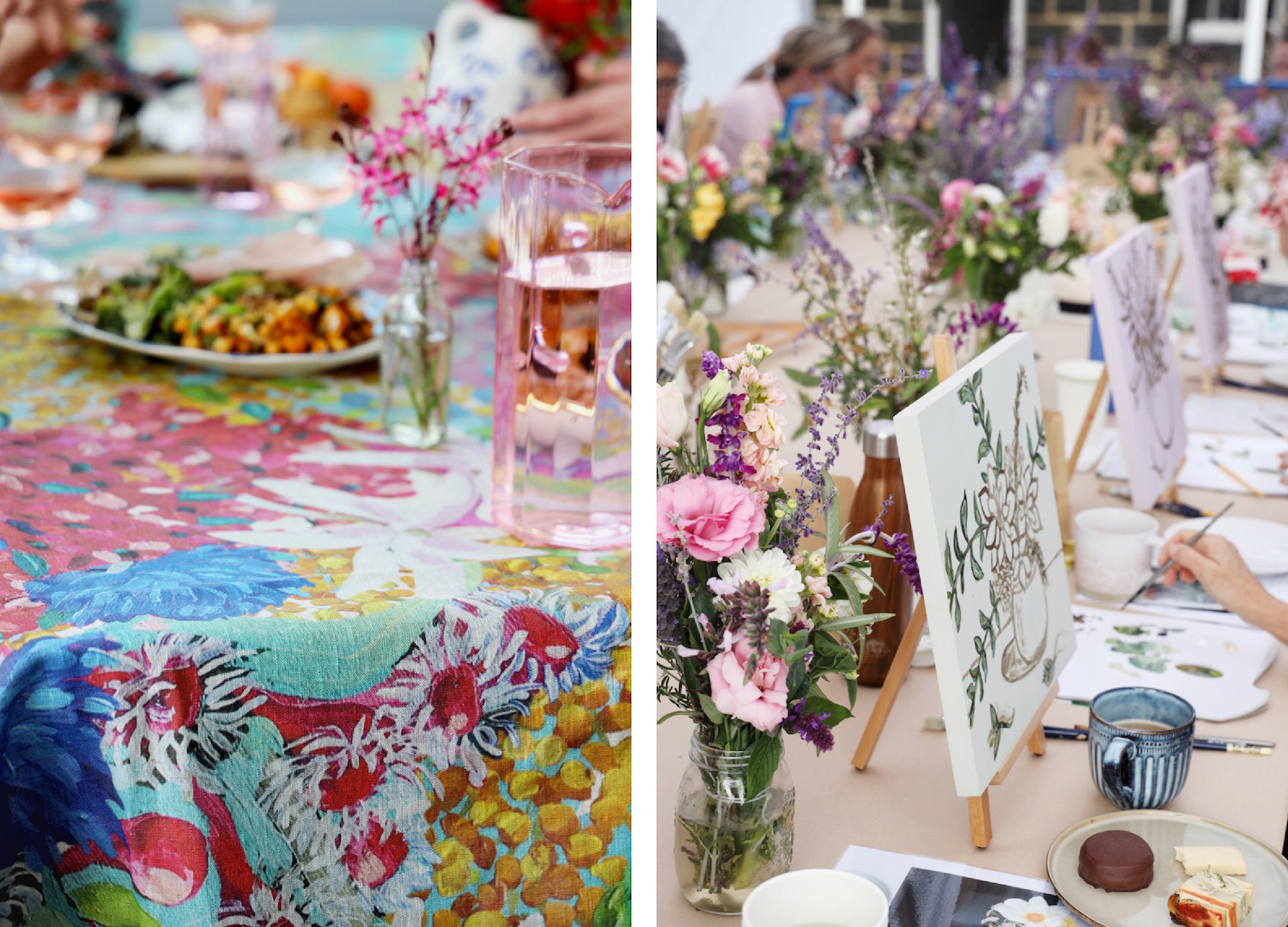
Art with Heart: Finding Beauty in the Everyday with Kate Quinn
photos COURTESY OF KATE QUINN
A powerful force for change, art can make a deep and moving impact on our hearts and minds. With so many talented creatives in Australia moving and shaking to make the world a better place – and because Earth without art is just ‘eh’ – we’ve introduced a new digital series called Art with Heart to showcase the superstars in our local art scenes.
Despite winning an art prize back in her school days, Brisbane’s Kate Quinn never considered full-time art as a viable career. A social worker for 20 years, doing important work in the domestic violence space, she dabbled in craft, but it was only in her mid-forties when she discovered her passion for painting. Now Kate paints vibrant depictions of still life that sing with blooming colour and gorgeous texture. She’ll be exhibiting a collection called Seasons alongside frequent collaborator and business partner Emily Day (the pair run Bloom Art Experiences) at Latrobe Art Space in Paddington from 11–16 July.

How did you come to be an artist?
Well, to be honest, it was sort of an accident! I’ve always enjoyed creative things, and did well at art in high school, but never considered art as a career. I trained as a social worker, did creative hobbies on the side and tried all sorts of things over the years, such as sewing, silversmithing and watercolours. About 10 years ago, when Instagram emerged, I was hugely inspired by artists I started following, in particular, Laura Jones. Her incredible still life paintings inspired me to try to learn to paint using oils, and I booked into a weekly art class to learn the basics. For the following six years or so, I just tinkered around using oils on canvas when I had time – which I mostly didn’t as I was raising three kids and working!
Then, three or four years ago, I decided I needed to put more dedicated time and effort into my painting practice, so I got more serious, created a dedicated art corner in a spare room of my house and started an art Instagram account of my own – this was hugely nerve-wracking at the time! Soon after, I entered the Jumbled Art Superstar competition and was lucky enough to win it (god knows how I managed that!). From that day, I was catapulted into an art business I never planned to have, and in the last few years, I’ve quit my job in social work, converted a larger room in my house into a studio and now paint full-time. I feel so incredibly lucky to have fallen into a career using the creativity that’s always been a part of me, but never expected to be able to make a living from (especially as I am mostly self-taught).

Tell us about your creative process…
I try to be pretty disciplined and routine about my painting practice and treat it like a regular job. As I work from home, it is difficult not to let house jobs, kid stuff and life admin creep into my painting time, so I try to exercise really early and get any chores out of the way by 9am each day so I can paint for a full day. I only paint one piece at a time, and like to focus completely on that particular painting. I need to feel a bit emotionally invested in each piece for it to work. That sounds a bit wacky I know, but I’ve learned the hard way that if I’m not properly focussed on a painting, it won’t turn out well. I paint alla prima, or wet on wet, so I’ll work on a single painting for one to five days in a row, depending on the size and the complexity of the piece.
READ MORE – Art with Heart: Disappear Into the Wonderful World of Monica Rohan
Regardless of whether I have the actual still life in front of me or not, I always work from a reference photo of the composition, to capture the light at one moment in time. I’ll often change, add or subtract elements in a composition, but I like to have the original reference photo as a guide on light and shade. I do a simple sketch in white pencil to nut out the basic shapes and sizing, then do all the detailed work with the paintbrush. I am not a fan of hog bristle brushes designed for oils, so prefer to use softer synthetic acrylic paint brushes; they feel much smoother to paint with. I work better when the house and studio are tidy too. This might just be procrastination, but the more organised I feel in my life generally, the more headspace I seem to have for the creative process.

Where do you find inspiration and what motivates you to create?
I see inspiration everywhere and need little motivation to create. Creative practice feels like an itch I have to scratch. Some days I don’t feel like painting, or feel a bit stuck on a particularly difficult painting, or am disheartened by a painting that hasn’t worked out so well, but I’ve learned that if I just sit down and start painting a little bit, I can push through that feeling of ‘stuck-ness’. I love trying new techniques, experimenting with new ideas and exploring unusual compositions – that keeps my practice feeling interesting and new.
As a floral still life painter, I find inspiration all around me – from my own garden which is full of flowers and the foliage I see in the street when I walk the dog, to the spectacular floristry design I see on social media. I never have any trouble finding something to paint!
I just love the familiarity of the objects and the beauty in the simple everyday nature of the things typically found in still life.
What drew you to still life?
I have always loved still life, both in paintings and in real life. In my home, I always have collections of ceramics, vessels, flowers and objects that I place into still life compositions without even thinking about them. I always have flowers in the house, mostly ones I grow myself or pick on walks. My favourite artists all paint still life and I can’t even really explain what draws me to it – I guess I just love the familiarity of the objects and the beauty in the simple everyday nature of the things typically found in still life.
Has your style or practice changed over time?
Yes and no! I learn ways to modify, simplify or improve my techniques all the time, mostly through trial and error, so my painting techniques have evolved a lot over the decade or so I have been painting using oils. That said, I have been painting floral still life the entire time, and that has never changed. Recently I have started painting animals, as a way to evolve my art and learn new things, and that has been a lot of fun, but floral still life will always be my first love!

Is there something you can’t live without in your studio?
My favourite thing is my very sturdy metal tube wringer – a TubeWringer 401 Heavy Duty. I’ve tried plastic ones before and they are rubbish. This one can get every drop of oil out of my paint tubes and it is so satisfying to use! I also couldn’t paint without natural light streaming in the window, a good quality standing easel, and Sunlight soap – it’s all you need to clean oily brushes and works just as well as turps.
The art people choose for their homes is a way of expressing who they are, where they belong and what matters to them.
Why do you think art is important to society and what could society do to better support artists?
Art, like music, books and drama, is incredibly important to us all for our mental and emotional wellbeing, expression of self and cultural identity – whether we know it or not. Art brings so much joy to people’s homes, especially if it has a special meaning or connection to an event, person or time in one’s life. The art people choose for their homes is a way of expressing who they are, where they belong and what matters to them. The act of creating art, the actual process of it, is just as important as the eventual product itself. For people who create, the act of creating brings a huge amount of joy and wellbeing, and getting into the state of ‘flow’ while creating is proven to improve the mental health of the creator.
For society to better support artists, local, state and federal governments could offer more opportunities for artists, such as grants, subsidies or competitions at no or low cost – this is especially important for emerging artists on very tight budgets. On a general level, it would be wonderful if art lovers appreciated the amount of time, money and effort that goes into creating every piece of art – years and years of practice, planning, sketching, sourcing materials, the time spent doing the creating, framing, packaging, shipping, social media, business administration, promoting and so much more. There is a vast amount of behind-the-scenes work in every painting I create that is so much more than simply time at the easel!
What are you working on currently that excites you?
At the moment I am preparing for an incredible joint exhibition titled Seasons in Paddington from 11–16 July at Latrobe Art Space. Seasons is an artist-led exhibition created by myself and my business partner Emily Day. We are collaborating with South Australian ceramicist Pia Kuykhoven and Toowoomba painter Chelsea Baker to create a stunning selection of floral still life paintings, handmade ceramics, seedpod sculptures, prints and candles, all themed around summer, autumn, winter and spring. Emily and I have painted 26 compositions each, both of us painting the same thing in our own style, colour palette and medium, to hang side by side. This is the first time I have run my own exhibition, and while it has been a vast amount of work for us, it’s been incredibly fun dreaming up all the concepts and ideas for this show.
Emily and I also run bespoke art workshops in unique locations across Australia – Bloom Art Experiences. We’ve been running these for just over 12 months and have been blown away by the positive response from participants. We have big plans for Bloom in the next year or two and this really fills my cup!

Who are your biggest artistic influences?
I’m obsessed with lots of Australian still life painters, such as Sam Michelle, Laura Jones, Emily Heath, Emily Day, Louise Vadasz, Michelle Fogarty, Dee Curran, Andrea Wilson, Anna Placidi and heaps more – too many to name! I’m also very influenced by some contemporary Australian florists, such as Bess Paddington and Flowers Vasette… in my next life, I’ll probably be a florist.
Art, like music, books and drama, is incredibly important to us all for our mental and emotional wellbeing, expression of self and cultural identity – whether we know it or not.
What’s your favourite work of art (not your own)?
What an impossible question to ask an artist, ha! How could I ever have just one? I do have an exquisite little floral still life watercolour I bought from Elizabeth Barnett years ago. It hangs in my bedroom and I love it every time I look at it.
What would be your ultimate dream project?
I would love to do a collaboration with a bedding or clothing brand, it would be so fun to see my art come to life in fabric. Gorman, are you listening?


